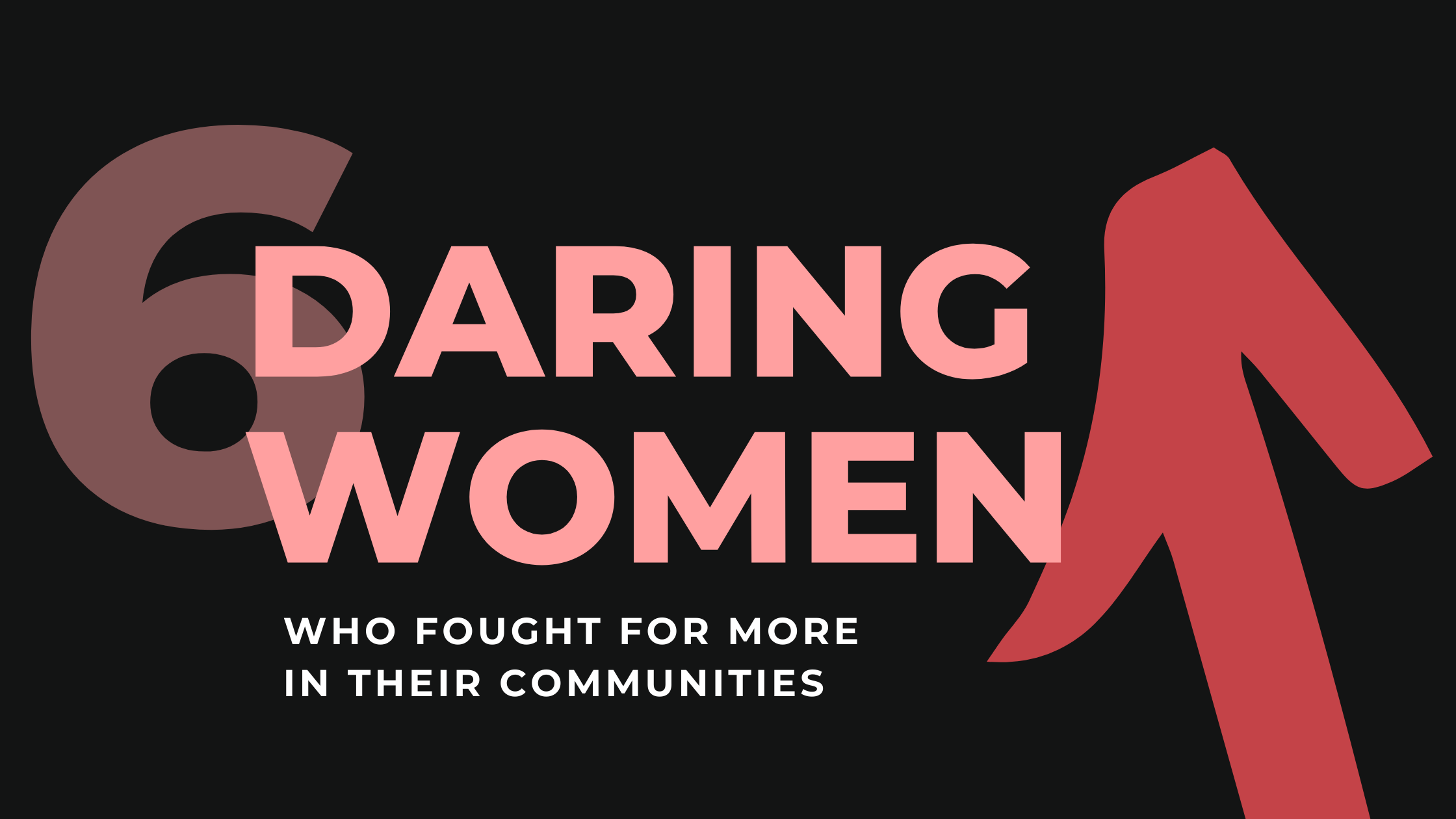
25 Mar Six Daring Women Who Fought for More in Their Communities
March is Women’s History Month, a month focused on celebrating the accomplishments of women throughout history and in the modern world. As a woman-led public participation consulting firm, we are excited to take part in this month by commemorating women that worked toward and advocated for equality, inclusivity, and accessibility.
Join us as we celebrate a few of the women trailblazers in urban design, transportation, greenspaces, environmental justice, accessibility, and equity and inclusion. These women not only paved the way for the work we do today, but inspire us to embody the same dedication, courage, and perseverance in our own work.

Jane Jacobs
(1916 – 2006)
Jane Jacobs was born as Jane Butzner in Scranton, Pennsylvania in 1916. After graduating high school, she began an unpaid position at the Scranton Tribune assisting the women’s page editor. After a year, she moved to New York City and over the course of several years, held a variety of jobs that got her accustomed to the city life.
In 1952, Jacobs became the associate editor of the Architectural Forum where she began to learn more about city planning and urban renewal. In this work, she noticed that many city projects were not safe, interesting, or economically feasible. These issues she observed inspired her to write her famous novel, The Death and Life of Great American Cities, published in 1961.
In the 1960s, Jacobs acted as an activist, protesting against clearing neighborhoods and highway expansion in New York City. She became a chairman of the Joint Committee to Stop the Lower Manhattan Expressway. In a demonstration protesting against the expressway in 1968, she was arrested. Nonetheless, the protests were successful as the Lower Manhattan Expressway was not built, showcasing the power of community voices and interests.
In 1968, Jacobs and her family moved to Canada in protest of the Vietnam War. She remained a critic of city planning, helping in a campaign to stop a highway from going through Toronto neighborhoods, called the Stop Spadina Campaign. Throughout the rest of her life, she wrote about and discussed topics such as gender differences in city planning, economics, morals, and social relations. In 1980, Jacobs attended the Boston Great Cities Conference with developer James Rouse and discussed the differences of men and women in planning. When Rouse emphasized the importance of big plans, “for [small plans] have no magic to stir men’s blood”, Jacobs famously responded: “Funny, big plans never stirred women’s blood. Women have always been willing to consider little plans.” *
Sources:
- Project for Public Spaces. (2010, January 2). Jane Jacobs. Retrieved March 22, 2021.
- *Brandes Gratz, R. (2011, November 16). Jane Jacobs and the Power of Women Planners. Retrieved March 22, 2021.
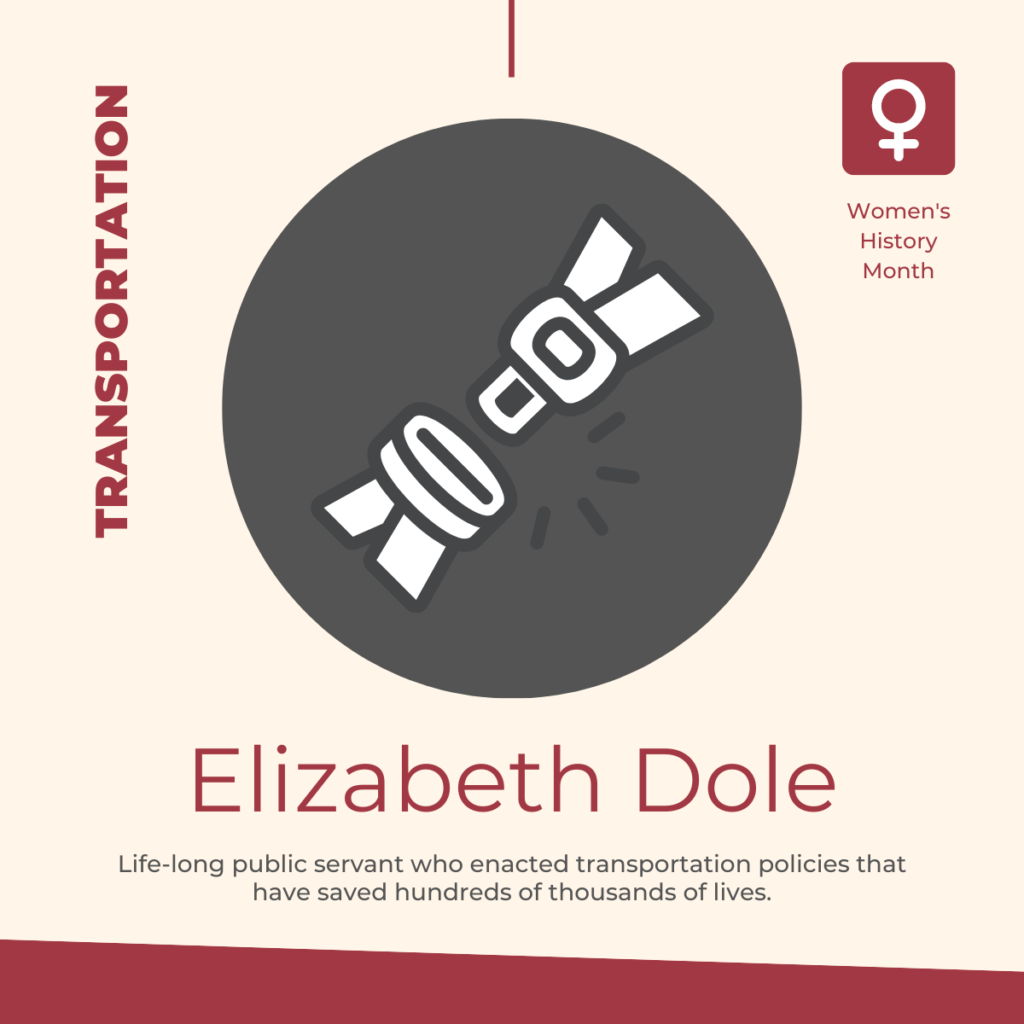
Elizabeth Dole
(1936 – )
Elizabeth Dole, a native of Salisbury, North Carolina, has had a life-long career in public service. Beginning in 1983, Dole spent four years as Secretary of Transportation. When she was sworn in, she was the seventh woman to serve in the cabinet and the first woman to head a branch of the armed forces (the Coast Guard).
As Secretary of the Department of Transportation (DOT), Dole enacted what is now known as the “Trifecta” of safety policies. First, she worked with the Senate to enact the 21-year-old drinking age. Around the same time, so developed regulation which led to the first state safety belt laws and air bag requirements in cars. These three actions are estimated to have saved 500,000 lives since the 1980s and about 20,000 lives per year. After examining evidence that brake lights reduced the total number of rear-end crashes, Dole also reversed a previous DOT decision that ruled against requiring brake lights on all new vehicles.
After her time as Secretary of Transportation, Dole went on to become the president of the American Red Cross, transforming the way blood donations were collected and distributed nationwide. In 2002, Dole became the first female senator representing North Carolina in the U.S. Senate. She later went on to establish the Caring for Military Families: The Elizabeth Dole Foundation in 2012, to raise awareness around military families caring for wounded soldiers and generating resources to support them.
Sources:
- Senator Elizabeth Dole. (2019, June 12). Retrieved March 18, 2021.
- United States of America, U.S. Department of Transportation, Federal Highway Administration. (1998). Women in Transportation: Changing America’s History (pp. 31-32).
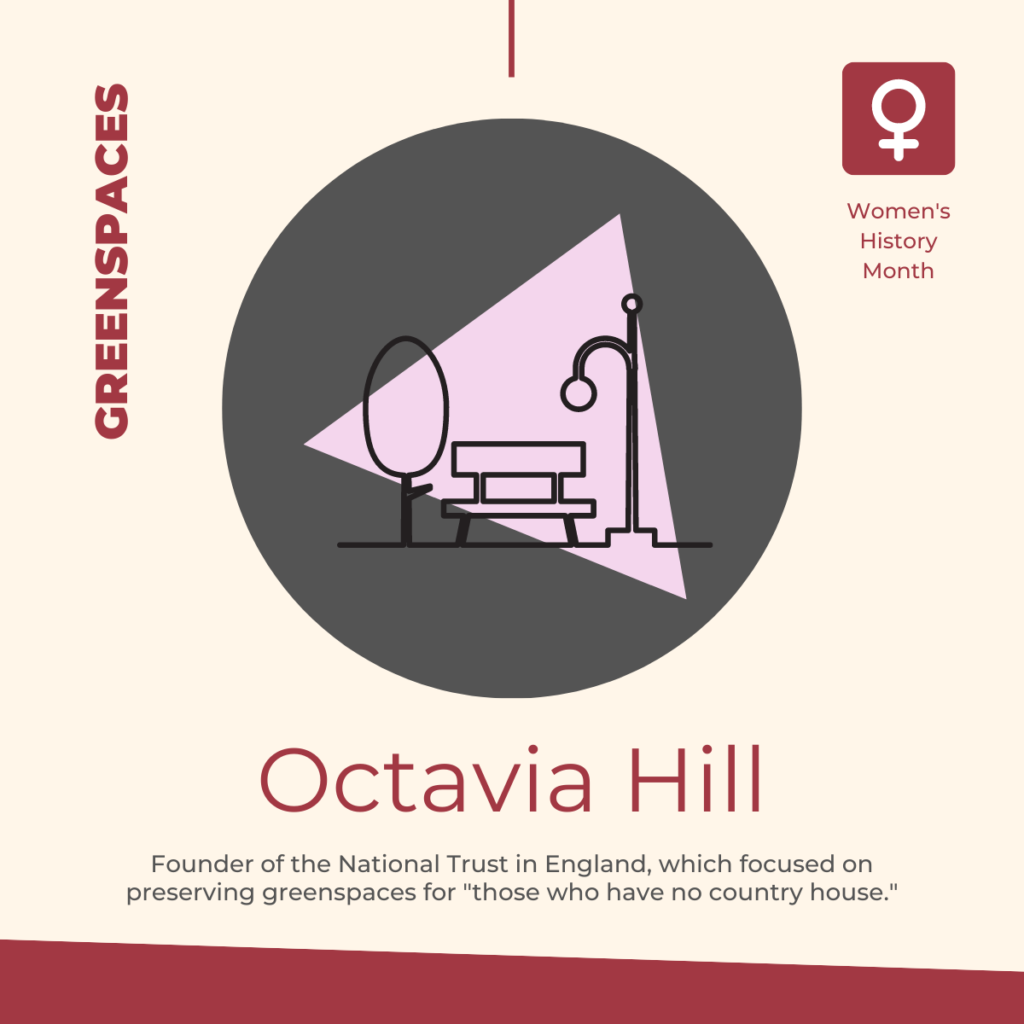
Octavia Hill
(1838 – 1912)
Octavia Hill was born on December 3, 1838 in Wisbech, Cambridgeshire. Her grandfather, Dr. Thomas Southwood Smith, was a public health reformer in Britain and worked towards better housing conditions for the working class. Hill’s parents were followers of Robert Owen, an urban socialist, and they founded the Wishbech Infant School, which was used as a service to the poor and a “Hall for the People” in the evening, holding lectures, dances, and meetings there.
Hill started working at 14 years old in a workroom at the Ladies Guild, a Christian socialist co-op that her mother managed. She made meals for the workers, visited them when they were sick, and took them on nature walks. Later, Hill became a property owner of London’s Paradise Place, purchased for her by John Ruskin. Ruskin was a mentor for Hill and he became her first investor with this property. Most landlords at the time charged 12% return on investment and practiced overcrowding in their property, but Hill only charged 5% and ensured the other money would go to beautification and upkeep of the community. By 1874, Hill had over 3,000 tenants around London.
Hill became focused on cultural philanthropy and with her sister, founded the Kyrle Society, intending to bring beauty, nature, art, and music to everyone. In her work around buildings as a landlord, she became interested in public open spaces. She became an activist and took part in campaigns against development across London. In 1895, she founded the National Trust for Places of Historic Interest or Natural Beauty with Hardwicke Rawnsley. The National Trust focused on preserving green spaces for those “who have no country house.”
Hill worked with the National Trust until her death in 1912, focusing on preserving the countryside in London and ensuring that all had the right of access to the land. The National Trust celebrated its 125th anniversary in 2020. Hill’s legacy also includes Octavia Housing, which continues to house thousands of people in London.
Sources:
- National Trust. (2015, July 28). Octavia Hill: Her Life and Legacy. Retrieved March 22, 2021.
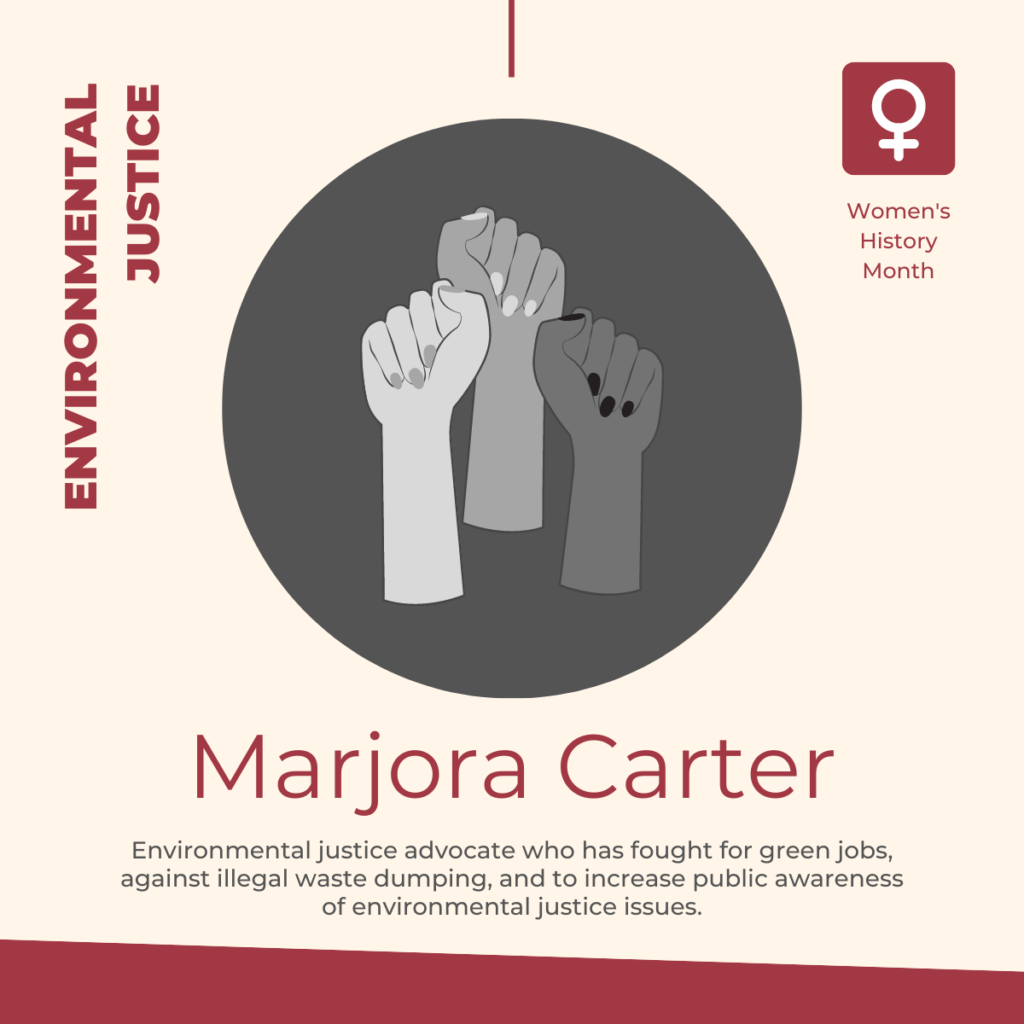
Marjora Carter
(1966 – )
Majora Carter was born in 1966 in the South Bronx. As a child, she was a part of the Head Start Program, a federal program that provides education, nutrition, health, and parent involvement services to low-income families. After graduating from the Bronx High School of Science, Carter attended Wesleyan University for undergrad and later attended New York University for her master’s degree. Carter began working as the Associate Director of THE POINT Community Development Corporation, a non-profit organization focused on youth development and cultural and economic revitalization of the South Bronx. In this position, Carter kickstarted development of Hunts Point Riverside Park.
In her work with THE POINT Community Development Corporation, Carter became an environmental activist. A company proposed a municipal waste transfer station along the Bronx River, even though the South Bronx was already handling 40% of the city’s commercial waste. She led protests against this effort and became a part of the Bronx River Working Group, a group focused on cleanup and restoration of the Bronx River.
In 2001, Carter founded Sustainable South Bronx, focused on environmental justice – especially in regard to illegal waste dumping in the Bronx River, air quality, fitness, and food choices. In 2003, Sustainable South Bronx started the Bronx Environmental Stewardship Training, an urban green collar training and placement program.
Later, Carter founded Green for All with Van Jones in 2007. This organization aims for a green economy that also lifts people out of poverty by creating more “green” jobs. After leaving Sustainable South Bronx in 2008, Carter started a private consulting firm, Majora Carter Group, LLC, focused on environmental justice and community outreach.
Carter has hosted several TED talks on her work. She appeared on a television show, The Green, which was focused on the environment. She also hosted a public radio show starting in 2008, The Promised Land, with Marge Ostroushko. This show won a Corporation for Public Broadcasting Talent Quest grant and was extended another season, and in 2010, the show won a Peabody Award. These are just a few examples of her work in increasing public awareness of environmental justice issues.
Sources:
- Holloway, M. (2008, December 13). The Green Power Broker. Retrieved March 22, 2021.
- Marjora Carter Group, LLC. (n.d.). Bio. Retrieved March 22, 2021.
- Waldman, A. (2001, August 15). A Dreamer, Working for Beauty in the South Bronx. Retrieved March 22, 2021.
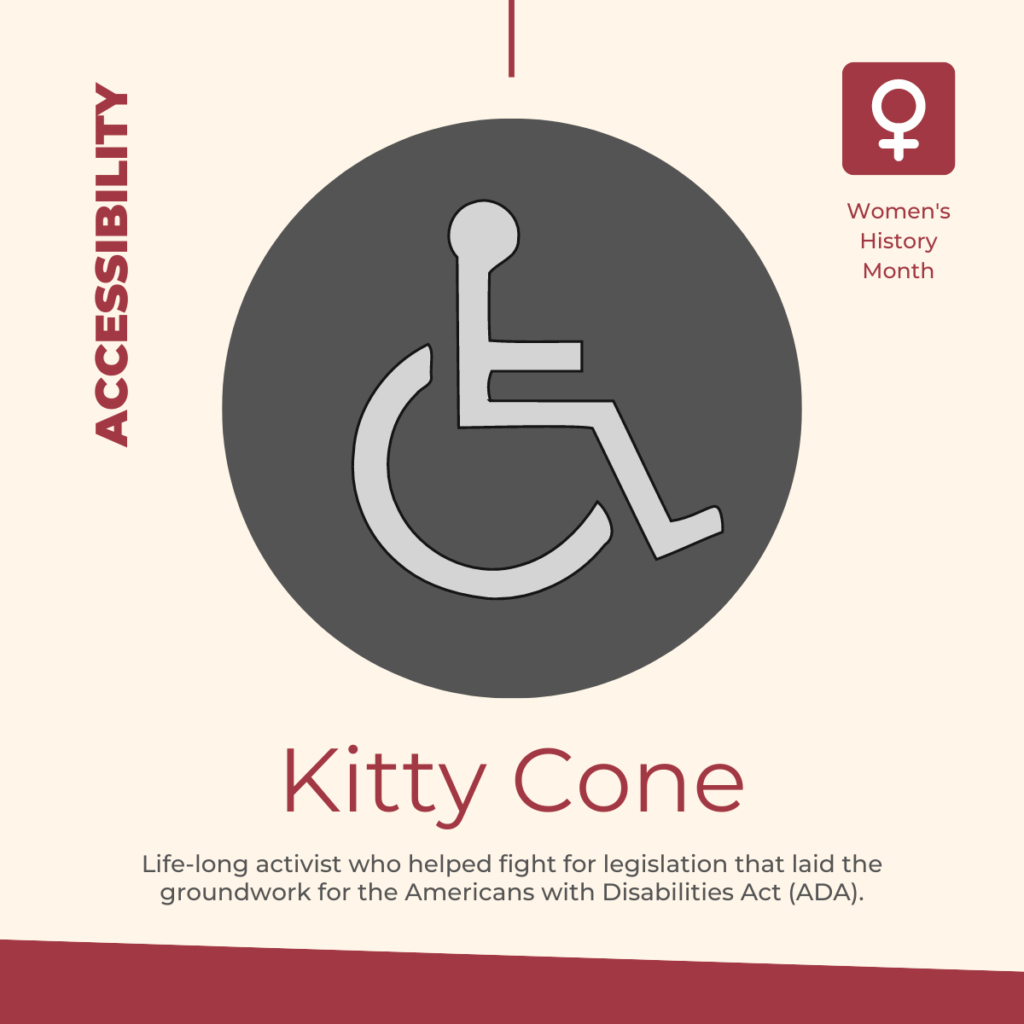
Kitty Cone
(1944 – 2015)
Kitty Cone began her activism in the realm of race and gender equality in the 1960’s. As a student activist at the University of Illinois, Cone began her advocacy against the apartheid in South Africa and racial segregation in the housing in the university town where she lived. She later traveled throughout Latin America, where she witnessed systemic poverty structures. These experiences led to her “life-long commitment to socialism as a means to social, economic, and political justice.” *
In the early 1970’s, after moving to the San Francisco Bay Area, she began using her organizing skills to advocate for “personal assistance services, curb ramps, and accessible public transportation.” * Her first venture into disability advocacy was focused on the Bay Area Rapid Transit (BART), advocating for it to be more accessible by retaining on-site staff at stations, adding elevators at stations, and helping those with disabilities feel more comfortable riding it. However, she also quickly became involved in a federal movement for disability rights.
Cone is known as a key leader in the occupation of the San Francisco federal building for 26 days in 1977. This sit-in urged the U.S. Health Education and Welfare Secretary, Joseph Califano, to enact Section 504 of the 1973 Rehabilitation Act. This Act was the first U.S. disability civil rights law that recognized disability services and accommodations as civil rights rather than acts of charity or rehabilitation. Section 504 removed funding from any public programs that discriminated against those with disabilities and laid the groundwork for the Americans with Disabilities Act (ADA).
Sources:
- Smithsonian. (2020). Kitty Cone: Advocate for disability rights. Retrieved March 18, 2021.
- *Disability Rights Education & Defense Fund. (2017, February 15). Celebrating Kitty Cone: 1944 – 2015. Retrieved March 18, 2021.
- Women’s Disability Activism. (n.d.). Retrieved March 18, 2021.
- The Regents of the University of California. (2000). Political Organizer for Disability Rights, 1970s-1990s, And Strategist for Section 504 Demonstrations, 1977. Retrieved March 22, 2021.
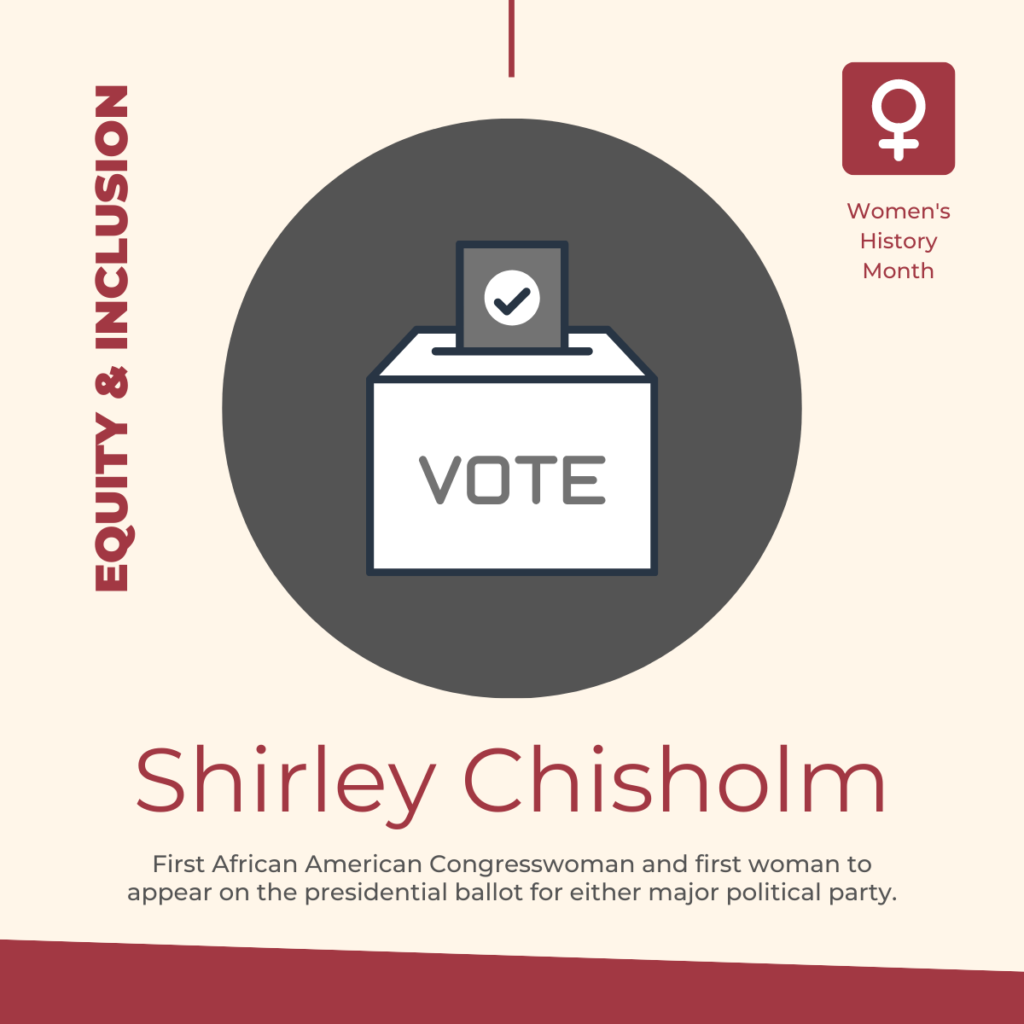
Shirley Chisholm
(1924 – 2005)
As an African American woman with two immigrant parents, Shirley Chisholm faced many barriers throughout her life. However, she became known as “Fighting Shirley” as she made her way through the political sphere, fighting for racial and gender equality in the United States.
After a tough election where Chisholm’s opponent attacked her on the basis of her gender, Chisholm was elected the first African American Congresswoman in 1968. She quickly faced opposition from other House representatives as she refused to sit quietly during her first term in the House, as was tradition. Chisholm fought for federal funding to expand daycare facility hours and for a guaranteed minimum annual income for families. She worked to expand federal assistance for the education system, including the provision of school lunches for children.
Chisholm later accepted a seat on the Rules Committee, which is one of the oldest committees in the U.S. Senate and develops the rules by which the Senate operates on a day-to-day basis. By accepting this position, Chisholm became the first Black woman and second woman ever to hold a seat on that powerful committee.
Representing the interests of Black, minority, and inner-city low-income citizens, Chisholm declared her candidacy for the 1972 Democratic presidential nomination. Chisholm’s campaign represented the first time a woman had ever appeared on the ballot of either major political party. Despite facing discrimination during her campaign, including being blocked from participating in primary debates, many still followed the “Chisholm Trail.” While she did not win the election, she did appear on 12 primary ballots and gathered 10% of the delegates’ votes. Her campaign pointed out pervasive gender discrimination, but it also paved the way for future women in politics.
Sources:
- U.S. House of Representatives. (n.d.). CHISHOLM, Shirley Anita. Retrieved March 19, 2021.
- Michals, D. (n.d.). Shirley Chisholm. Retrieved March 19, 2021.
Don’t forget to subscribe to the P3 monthly newsletter for exclusive community engagement tips and to never miss a blog post!
About the Authors:
Deirdre Scanlon is the Communications Engagement Manager for Public Participation Partners (P3). When not dreaming up new ways to equitably engage the public, you can find Deirdre tending to her houseplants or walking the trails of Raleigh, NC.
Katie Maynard started her journey with Public Participation Partners as a Community Engagement Assistant in January 2020. When not assisting with public involvement, Katie enjoys reading, traveling to the beach, and spending time with her pets.


Sorry, the comment form is closed at this time.